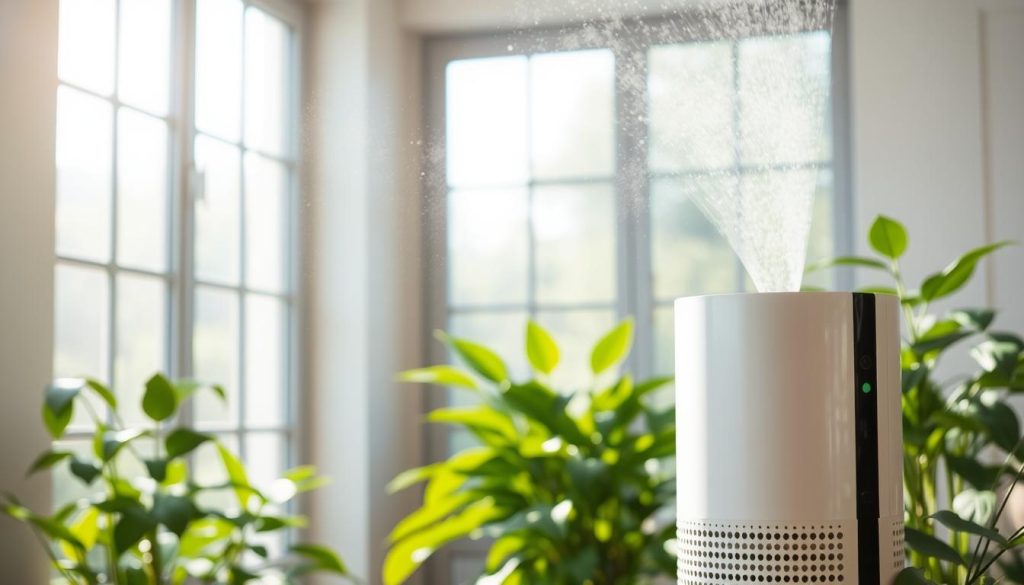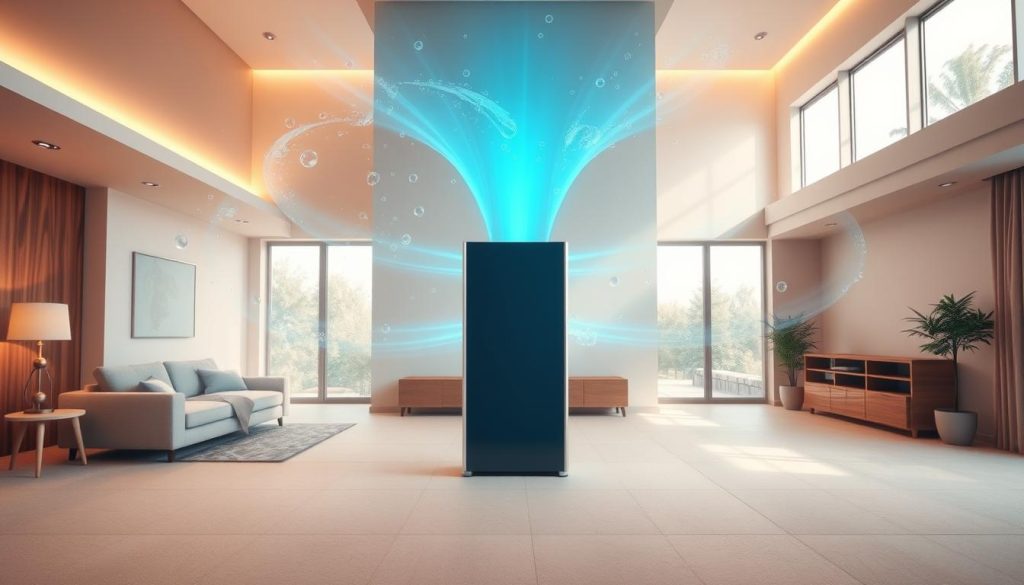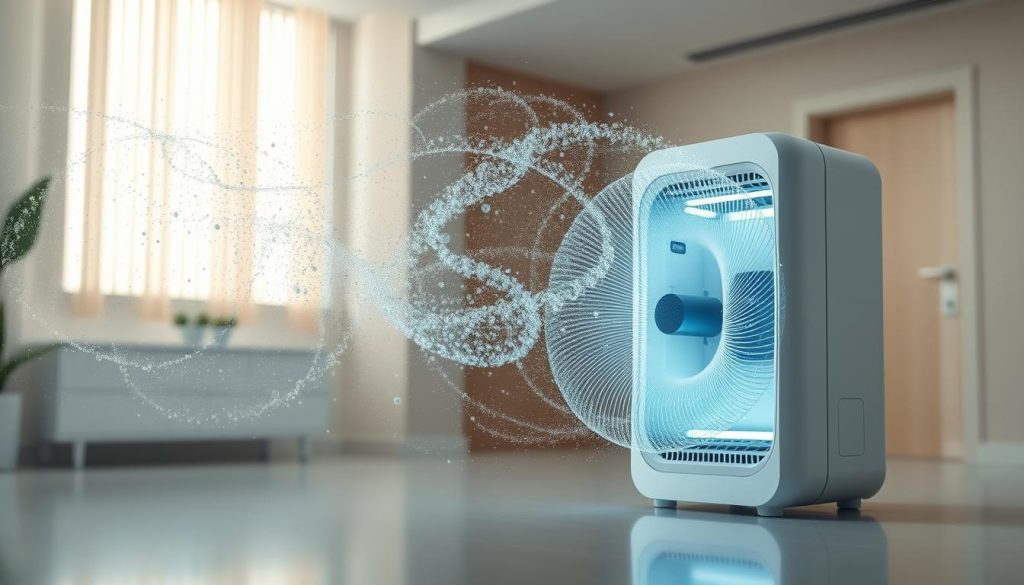Imagine walking into your home and feeling a fresh indoor atmosphere that refreshes you. This is what negative ions for clean air can do. As people worry more about air quality, they seek ways to make their homes healthier. Negative ions are nature’s way to clean the air, improving health and well-being.
Negative ions are found in nature, like near waterfalls and after storms. In our homes, they help remove pollutants and allergens. This makes the air cleaner and fresher. The health benefits of negative ions include fighting airborne bacteria and improving mood and breathing.
Adding negative ions to your home can make it a haven of fresh air and health. Learning more about how these ions work and their benefits will show why a negative ion generator is a great investment. It can change your home’s atmosphere for the better.
What are Negative Ions?
Negative ions are tiny, invisible particles with an extra electron. They help improve air quality in many ways. You can find them in places like forests, waterfalls, and mountains, where the air feels fresh and lively.
Understanding Their Formation
Negative ions are made through natural events like sunlight and moving water. They can also be created by devices like air purifiers. These devices use ionization technology to make these helpful ions.
When energy from these sources hits air molecules, it takes away electrons. This leaves the molecules with an extra electron, making them negative ions.
How Negative Ions Interact with Air Molecules
After they’re made, negative ions start to bond with particles in the air. This includes dust, pollen, and smoke. When they bond, these particles get heavier and fall to the ground or get caught in filters.
This process helps clean the air by removing allergens and pollutants. It makes the air healthier to breathe.
- Natural Sources: Waterfalls, Forests, Mountains
- Artificial Sources: Negative Ion Generators, Air Purifiers
Using negative ion production to improve air quality is both scientifically backed and practical. It’s a great way to make indoor air cleaner.
Benefits of Negative Ions for Clean Air
Negative ions are great for cleaning the air we breathe. They cut down on pollutants like dust, mold, and pet dander. This makes our homes healthier.
They do more than just clean the air. They also boost our mood. Studies show that negative ions can make us feel better and less stressed.

Negative ions also help reduce allergens. This is good news for people with allergies or asthma. They get rid of airborne irritants.
Experts, like the American Lung Association, say negative ions are good for our lungs. They improve the air quality inside.
To understand the benefits of negative ions better, look at the table below:
| Benefits | Description |
|---|---|
| Health Benefits | Improved respiratory health, lower stress levels, and enhanced overall well-being. |
| Mood Improvements | Elevated mood, reduced anxiety, and increased serotonin levels. |
| Allergen Reduction | Elimination of dust mites, pollen, and other airborne allergens. |
Negative ions are very beneficial for our health and mood. They make our homes cleaner and healthier. It’s smart to use negative ion technology in our daily lives.
Negative Ion Generators: An Overview
Negative ion generators, also known as ionic air purifiers, are popular for improving home air quality. They release negative ions that stick to pollutants and allergens in the air. This makes them great for anyone wanting cleaner air at home.
Types of Negative Ion Generators
There are many types of negative ion generators, each suited for different needs. Here’s a look at the main types:
| Type | Operation | Best For |
|---|---|---|
| Standalone Units | Plugged into an outlet, these units can be placed in any room and usually feature adjustable ion output settings. | General household use, movable between rooms |
| HVAC-integrated Systems | Integrated into the home’s HVAC system, providing comprehensive coverage throughout the home. | Homes with central heating and cooling systems |
| Portable Models | Compact and battery-operated, suitable for on-the-go use in cars, offices, or hotel rooms. | Travelers, small personal spaces |
Choosing the Right Generator for Your Home
Choosing the right ionic air purifier depends on several factors. Consider room size, air quality needs, and budget. Here are some tips:
- Room Size: Make sure the unit’s capacity fits the room size. Larger rooms might need more powerful units or more devices.
- Specific Needs: Check if you need extra features like HEPA filters. They can improve air quality even more.
- Budget: Standalone units are often cheaper. But, integrated systems offer better coverage for the whole home, even if they cost more.
Understanding these factors and how different generators work can greatly improve your home’s air quality. This leads to cleaner air and a healthier living space.
How Negative Ions Improve Indoor Air Quality
Negative ions are key to keeping indoor air clean. They stick to dust, smoke, pollen, and pollutants, making them fall. This makes the air healthier to breathe.

Studies show negative ions help fight airborne diseases. The Environmental Protection Agency (EPA) found they slow down bacteria and viruses. This is good news for our health.
Using negative ions also boosts our well-being. It improves our breathing, gives us more energy, and helps with allergies and asthma. Adding negative ion technology to our homes is a smart move for better health.
Incorporating an Air Purifier with Negative Ions
Adding an air purifier with negative ions to your home can greatly enhance air quality. Here’s a look at some top-rated negative ion air purifiers. We’ll also cover important features to consider.
Top Models Available
Several air purifiers with negative ion technology stand out. Here are some top models:
- Dyson Pure Cool TP04: This model is known for its strong filtration and air purification. It also monitors air quality in real-time.
- Molekule Air Mini+: It’s compact and perfect for small spaces. It uses PECO technology for better indoor air purification.
- Blueair Blue Pure 211+: This unit has a highly efficient HEPA filter and generates negative ions. It’s great for large rooms and is energy-efficient.
Key Features to Look For
When choosing an air purifier, look for these key features:
- Coverage Area: Make sure the purifier fits the space you need. For example, the Blueair Blue Pure 211+ works well in rooms up to 540 square feet.
- Power Consumption: Choose energy-efficient models to save on electricity costs. Many top-rated air purifiers are designed to be power efficient.
- Maintenance Requirements: Opt for units with easy-to-replace filters and minimal upkeep. Easy-to-use designs make maintenance simpler.
The Science Behind Ionization Technology
It’s important to understand how ionization works to see why it’s good for air cleaning. This part explains how ionization, like electrostatic air purification, helps keep the air clean.
Electrostatic Precipitators Explained
Electrostatic precipitators are key in ionization-based air cleaning. They use a high-voltage charge to make particles in the air stick to plates. This way, they remove pollutants from the air. It’s great for catching small particles, making it a top choice for clean air.

Comparing Ionization and Filtration Methods
Ionization and filtration have their own strengths and weaknesses. Ionization is better at catching small particles that filters can miss. But, filters might work better for bigger particles and smells. Here’s a comparison of the two:
| Feature | Ionization Technology | Filtration Technology |
|---|---|---|
| Particle Size Efficacy | Excellent for fine particles | Effective for larger particles |
| Maintenance | Low, cleaning collection plates | Moderate, replacing filters |
| Energy Consumption | Lower | Higher |
| Odor Removal | Moderate | High |
| Cost | Medium initial, low upkeep | Variable, high upkeep |
Choosing between ionization and filtration depends on what you need. Knowing about ionization and its role in air cleaning helps you make a smart choice for better air quality.
Impact of Negative Ions on Respiratory Health
Negative ions help improve breathing by cleaning the air. They pull in and neutralize pollutants, making the air cleaner. This is good for people with asthma and allergies.
When negative ions meet airborne particles like dust and pollen, they become too heavy to stay in the air. This means less irritation for our lungs.
Studies show that air purifiers with negative ions are very effective. They help people with asthma and allergies by removing triggers. This leads to better breathing and fewer problems.
Researchers also found that negative ion generators reduce allergy symptoms. These devices keep the air in your home healthy. They are key for those looking to improve their breathing.
Fresh Air and Clean Breathing Through Ionized Air
Adding negative ion technology to your home or office makes the air much better. It gets rid of bad smells, making your space feel fresher. This means every breath you take is cleaner, making your indoor area healthier and more pleasant.
With negative ion generators, the air feels like a breath of fresh air outside. These ions fight off pollutants in the air, making your space cleaner and more lively. This not only makes your home smell better but also helps you breathe easier by removing harmful particles and allergens.
The change is really noticeable. The air feels crisp, bad smells disappear, and breathing gets easier. This makes your home a healthier and more comfortable place for everyone. Negative ion technology is a great addition to any indoor space.
Setting Up an Effective Air Purification System
Creating a clean environment means choosing the right air purifier and placing it correctly. Regular maintenance is also key. Follow these easy steps to set up and care for your system.
Placement and Maintenance Tips
Where you put your air purifier matters a lot. Place it in busy spots like living rooms or bedrooms. Make sure it has space around it for air to flow freely.
Keeping your ionizers in good shape is important. Clean the filters often and change them when needed. Also, check the device for damage and clean the ionization plates regularly.
Maximizing Efficiency for Health Benefits
To get the most out of ionized air, add a routine to your air purifier use. Close windows and doors when pollution is high. Use an air quality detector to keep an eye on your air.
Adding air-purifying plants like ferns or spider plants can help too. Make sure your air purifier fits your room size. These steps will make your home healthier.
| Tip | Description |
|---|---|
| Placement | High-traffic areas, a few inches from walls or furniture |
| Maintenance | Regular filter cleaning, replacing as needed, check for wear |
| Additional Tips | Close windows during high pollution, use air-purifying plants |
Real-Life Experiences: Stories of Clean Air with Negative Ions
Negative ion generators have greatly improved air quality and health. People’s lives have been changed for the better. These devices bring many benefits to our homes.
Testimonials from Users
Many have shared how negative ions have changed their homes. Mary Thompson from New York said, “A negative ion generator in my home has cut down allergies and improved our health.” Mark Richardson, a tech lover, added, “Our home feels fresher and more alive with negative ions.”
These stories show how well negative ion generators work. They make the air healthier and more comfortable. This is very important in cities with a lot of pollution.
Living in a Healthier Environment
Families are adapting well to living with negative ions. They’ve seen fewer pollutants and allergens. This means cleaner, fresher air at home. Julia Brown from California said, “Our home’s air feels cleaner. Even our pets seem happier!”
These stories prove the importance of negative ions in creating healthier homes. They show that using negative ion generators can greatly improve air quality and health.
Future Trends in Air Purification
The future of negative ions in air purification looks very promising. We’re on the verge of better air purifying systems thanks to ongoing technology advancements. These systems will make the air we breathe cleaner and improve our health and well-being.
Smart technology is set to change the game in air purification. Next-generation devices will use advanced sensors and AI to work better in real-time. They’ll adjust to air quality changes, ensuring clean air always. This will make high-quality air purification available to more people, improving our living spaces.
Expect better efficiency and design in these systems soon. Future models will use less energy, be quieter, and take up less space. This will make them easy to fit into homes and businesses. Cleaner air will lead to fewer respiratory problems and better health for everyone. With these advancements, the future of negative ions is looking very bright, promising a healthier world for us all.

